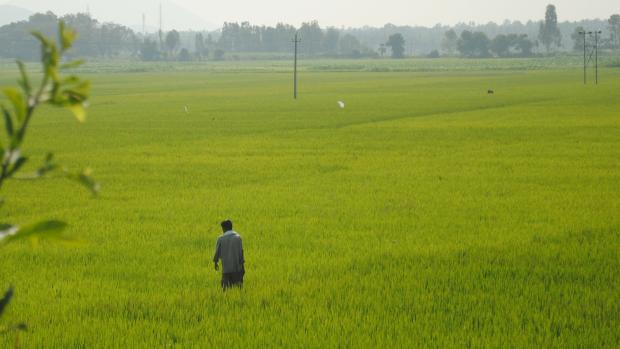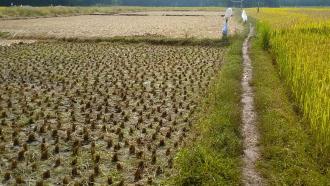
Photo : Purabi Deshpande / Research Matters
It was in the 1970s that the term ‘climate change’ was coined. Agriculture is one sector that both contributes to and affected by climate change, and research around the world is now advancing towards ‘climate-smart’ agriculture. Carbon or carbon dioxide is one of the culprits for the rising temperature across the globe. Agricultural operations such as tillage, fertilization, irrigation, crop protection and so on are responsible for release of CO2 and other greenhouse gases from agricultural landscape to atmosphere. On the other hand, agricultural crops are large sinks of carbon, thanks to photosynthesis that uses carbon dioxide from the atmosphere. With increasing effects of climate change in agriculture, transformation of agricultural practices to cope with the changing climate and reduce agriculture’s effect on climate change has been a subject of scientific investigation recently.
‘Conservation agriculture’ is touted as a new approach based on the principles of minimum soil disturbance, appropriate crop rotation and retention of crop residues that can contribute in reusing carbon and reducing greenhouse gas emissions. It also one of the areas that Dr. Tek Sapkota and his team at the International Maize and Wheat Improvement Centre in New Delhi are trying to lay the groundwork for. The researchers have run a number of long-term field experiments to evaluate the performance of conservation agriculture under different cropping system and agro-ecologies in South Asia. One of such experiments is in the research farm of Rajendra Agricultural University, Samastipur, Bihar where researchers are investigating changes in the carbon content in agriculture soils by trying out some unconventional methods besides studying agronomic performance. Their results were published in the Journal of Soil Use and Management.
Rice and wheat, India’s major crops cultivated extensively in the Indo-Gangetic plains, were studied as a part of this experiment. Started in 2006, the researchers experimented with eight combinations of tillage, crop rotation and residue management practices. Unlike conventional methods of growing rice and wheat crops where fields are cleared after harvest either by burning or feeding to cattle, ‘conservation agriculture’ retains the crop residues in the soil after the harvest, which is left undisturbed. The new approach also employs reduced or zero tillage to the soil to enrich the soil and improve its physical properties.
After 7 years of experimentation, the researchers observed an increase in the carbon content of soil to around 3.0 - 4.7 tons per hectares with the combination of zero tillage and residue retention, a three-fold increase compared to conventional treatment of soil.
Tilling of soil before sowing seeds is a common practice followed in traditional agriculture. This is to ensure a good supply of air to the roots and loosen the soil to promote growth of plants. But how would then zero tillage ensure these essential processes of agricultural production? "In the zero tillage method, the soil is more aerated than conventional tillage because of less vehicular traffic and higher population of earthworm and other beneficial micro-organisms", elucidates Dr. Sapkota. This apart, the zero tillage method has other benefits. "The population of Phalaris minor, a notorious weed found in wheat farms, is drastically reduced under this method. There are current studies going on to see the effect of zero tillage on other pests," he adds.
With increasing demand of fertilizers and limited mineral resource on earth, new methods of fertilization are also emerging. "By using conservation agriculture methods, the use of chemical fertilizers can be reduced by 20-25% after 2-3 years when the residues start decomposing and releasing nutrients in the soil," says Dr. Sapkota.
The study gives prominence to the fact that retaining crop residues in agricultural soil not only reduces environmental pollution from residue burning, but also improves soil quality in the long term. Although conservational agriculture approach in India is presently focused more on rice, wheat, maize, soybean and cotton, this approach can be used for other crops as well, say the researchers.
The present study was a first-ever experiment on conservational agriculture in the Eastern Indo-Gangetic region that compares various combinations of tillage and crop establishment methods to examine the carbon content in the soil. "This study continues and the research team is monitoring the long-term effect of conservation agriculture on soil carbon and nitrogen dynamics, effect on soil micronutrients, pest and pathogen dynamics, water and environmental footprint and so on," signs off Dr. Sapkota talking about the future roadmap.
With agricultural practices now being modified to live with climate change, perhaps it could now help address this devastating condition sooner than later and promise plenty of food for all in the days to come.






